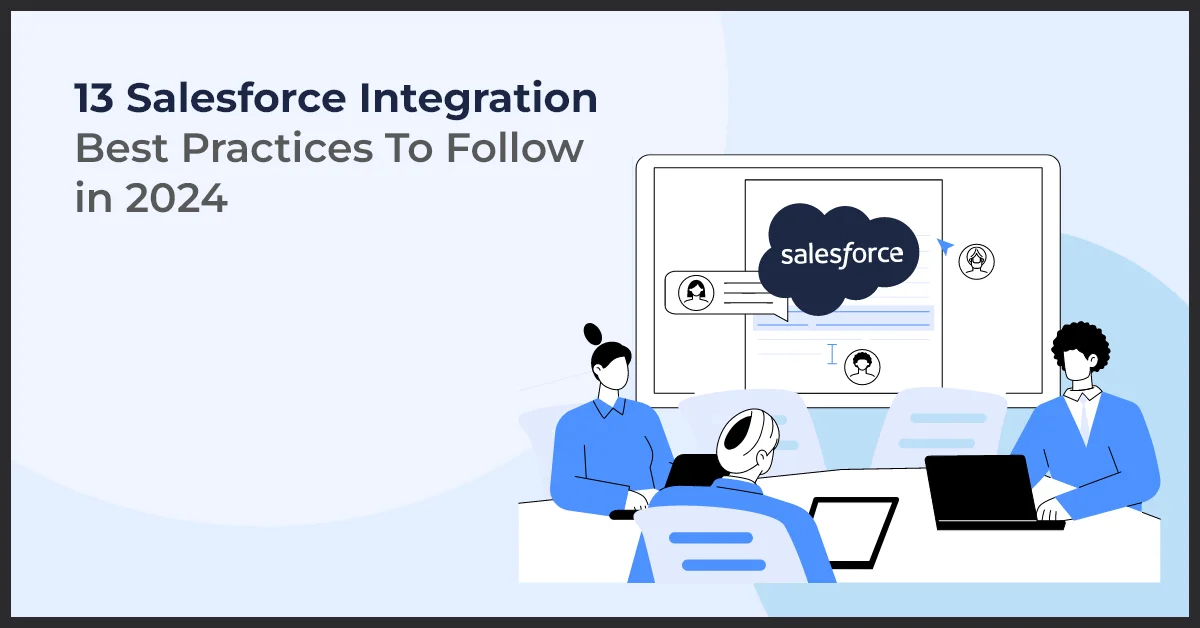13 Salesforce Integration Best Practices To Follow in 2024

Published on: September 9, 2021
Updated on: October 02, 2024
2216 Views
- Salesforce
8 min read
Businesses can quickly become trapped using disjointed systems that create data silos, frustrated employees juggling logins, and no unified view of customers. This fractured landscape makes it challenging to serve clients, oversee projects, and operate strategically.
A strong Salesforce integration strategy unifies data in one actionable hub to provide a 360-degree customer view, aiding tailored strategies that enhance customer relations and sales. This boosts sales, marketing, and customer service team productivity, providing real-time, consolidated data access.
In this post, we will cover 13 Salesforce integration best practices and the value of consulting with integration experts to enhance ROI.
13 Salesforce Integration Best Practices
In 2024, staying at the forefront of integration strategies is crucial for businesses aiming to optimize workflows and enhance productivity. Here are some Salesforce integration best practices to follow in 2024:
1. Begin with a Business Strategy and Roadmap
Every project requires investment and effort. Mapping business goals and expected ROI is crucial. Use interviews and surveys to understand stakeholder perspectives on what constitutes a successful Salesforce integration.
Key Question: How does this project align with the organization's business and technology strategy? This will largely define the project’s completion criteria.
Conduct a gap analysis to compare systems and processes' current and future states. This analysis should inform the requirements gathering phase for the Salesforce integration project.
2. Select Integration Pattern and Approach
Salesforce integration projects fall into three categories. Choosing the correct pattern and approach at the planning stage is vital. It will influence the selection of integration platforms and tools.
Broadly, there are three patterns:
- Data Integration: Focuses on syncing data between external systems and Salesforce, aligning with the organization's data strategy and governance.
- Process Integration: Involves Salesforce interacting with external systems to complete tasks or vice versa. Key considerations include trigger events, exception handling, and process state management.
- Virtual Integration: Allows real-time access to data from multiple systems without local data storage, requiring careful data access and security planning.
Develop a matrix to match integration patterns with business use cases.
3. Collaborate with Key Stakeholders
Project success hinges on stakeholder collaboration. Here are steps to ensure effective collaboration:
- Involve stakeholders early in the planning phase.
- Clarify project objectives, problems, and solutions.
- Outline the proposed solution, systems involved, and required changes.
- Conduct a detailed impact analysis and risk management strategy.
- Obtain stakeholder approval and secure the budget.
- Publish the project plan, timelines, and governance framework.
- Include stakeholders in User Acceptance Testing and Training.
4. Choose the Right Implementation Team
Select a team with the right skill sets and cultural fit. Use a RASCI matrix to define roles and responsibilities. This clarifies who is Accountable, Supports, Consulted, and Informed.
In addition to internal players, the right Salesforce partner is invaluable. Blend partner expertise with internal staff to build a balanced dream team. With complementary skills and experience, this all-star line-up is equipped to integrate systems seamlessly.
5. Determine Integration Type (Pull/Push)
An essential planning step is deciding the integration architecture. Will Salesforce pull/push data to/from external systems? Will those systems pull/push data to/from Salesforce?
This impacts methods, triggers, and sync frequency. Carefully consider which integration type best fits the business use case.
For example, scheduled bulk updates from an ERP may involve pulling data into Salesforce. Real-time order processing could require pushing data from Salesforce to other systems.
Some common patterns are:
- Pulling data on a schedule for reporting or syncs
- Pushing real-time data for transaction processing
- Hybrid approaches to balance integration needs
Additionally, factor in Salesforce governance and API limits.
6. Leverage Middleware
When integrating Salesforce, a Middleware platform often outperforms point-to-point integration. This aligns with Salesforce integration best practices in several scenarios:
- Multiple systems: Middleware eases maintainability, synchronization, and data integrity across systems.
- Large data volumes: Middleware handles high data throughput between Salesforce and other solutions.
- Data transformation needs: Perform complex calculations outside Salesforce and source systems using Middleware.
- Shared data ownership: Middleware helps manage shared data across multiple platforms.
With Middleware, integrations are more scalable, efficient, and resilient.
When assessing middleware tools, consider skills, ease of use, features, connectivity, and cost. Prepare an evaluation matrix to select the optimal platform. Also, review AppExchange packages to reuse existing Middleware potentially.
For simple two-way data exchanges, point-to-point integration may suffice. But for complex projects, Middleware aligns with Salesforce integration best practices and delivers significant advantages.
7. Assess Native Salesforce Features and Integration Tools
Evaluate Salesforce's native features and other tools for robust integration architecture, including External ID, External Objects, Salesforce Connect, Connected App, Integration User, Federation ID, Named Credentials, Remote Site Setting, Custom Metadata, and Batch Jobs.
8. Manage Data Ownership in Salesforce Integrations
Carefully consider data ownership when planning integrations. Key questions include:
- Is any sensitive data being exchanged? If so, you may need to encrypt data.
- Do multiple systems own/store the same data? Sync frequency and conflicts need resolution.
- Is data replicated or stored centrally? This impacts access controls.
- What are the real-time vs. batch processing needs? Architecture must support both.
- How much data is shared? Volume impacts architectural decisions.
- How is access to shared data controlled? Identity and access management are crucial.
The middleware platform should enable data security during transfers. For shared
data access across systems, implement systematic user access controls.
9. Assess Scalability and Maintainability
Ensure the solution is adaptable to changing business and technology needs and is easy to maintain. To maximize scalability and maintainability:
- Adopt standard integration patterns and interfaces. Avoid custom-coded shortcuts.
- Design with change in mind. Loose coupling and separation of concerns add flexibility.
- Use mature, supported middleware tools. Build on platforms made for scale.
- Skills development and documentation are crucial for team continuity.
With a disciplined, forward-looking approach, Salesforce integrations flex and endure over time. Plan scalability and maintenance upfront to avoid ad-hoc scrambling as needs grow.
10. Establish Effective Data Governance
Ensure data integrity and uniformity across all integrated systems by adopting strong data governance practices. Set clear data quality standards, assign data ownership, and synchronize data between Salesforce and other systems consistently. Apply data validation rules, strategies for deduplicating data, and transformation routines to maintain a unified data source.
11. Utilize Salesforce APIs Effectively
Harness the full potential of Salesforce's robust APIs, including REST, SOAP, and Bulk APIs, to ensure smooth integration with external systems. Select an API that aligns with your specific integration needs.
Keep up with API versioning to maintain compatibility and prevent disruptions from Salesforce updates. Adhere to API security best practices, like using OAuth 2.0 for authentication and encrypting sensitive data.
12. Review and Refine the Project Plan
Regularly update the project plan based on stakeholder feedback, scope changes, and risk assessments. Perform detailed testing to uncover and rectify integration issues before deployment.
Test various scenarios, including data mappings, error conditions, and exception handling. Employ automated tests and regression testing to evaluate future updates or enhancements efficiently.
Govern the iteration process and phase of the project based on complexity, considering an MVP for the first phase and a roadmap for subsequent steps.
13. Develop Strong Error Handling and Monitoring
Establish a comprehensive error-handling framework to manage exceptions and errors in integration processes. Employ effective logging and monitoring methods to keep track of integration activities and quickly identify issues. Configure notifications or alerts for integration failures to enable prompt action and avert data discrepancies.
The Importance of Salesforce Integration Services
Salesforce integration can be intricate and time-intensive, particularly for organizations with limited internal IT capabilities. Salesforce integration services and consulting experts play a crucial role by providing:
- Expertise: Specialists in Salesforce integration services bring a wealth of experience in integrating Salesforce with various systems and applications. They understand common challenges and offer solutions based on industry best practices.
- Customized Solutions: Every business has unique integration needs. Salesforce integration consultants evaluate your requirements and develop tailored solutions aligning with your business objectives. They can also propose additional features and improvements that might not have been previously considered.
- Implementation and Ongoing Support: Salesforce integration service providers manage the entire process, from planning and design to implementation and ongoing support. This approach lets your internal team focus on their primary responsibilities while experts handle the technical details.
- Cost-Effectiveness: Collaborating with Salesforce integration experts can lead to significant cost savings. These professionals help avoid expensive errors, reduce downtime, and ensure a smooth and efficient integration process, yielding long-term financial benefits.
A Salesforce Partner You Conclusion
As businesses navigate the dynamic landscape of 2024, adopting best practices for Salesforce integration is paramount for sustained success.
By incorporating these best practices into your Salesforce integration strategy in 2024, you can position your organization for success in a rapidly evolving technological landscape.
Stay agile, prioritize security, and harness the latest advancements to unlock the full potential of your integrated Salesforce ecosystem.
Following these Salesforce Integration best practices is critical to maximizing your ROI. But, integration is complex.
Want a Seamlessly Integrated Salesforce Ecosystem? Let’s Talk!
Our Salesforce-certified experts would love to pitch in. Just write to us at info@growthnatives.com and we’ll get back to you.



